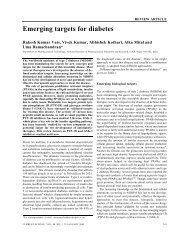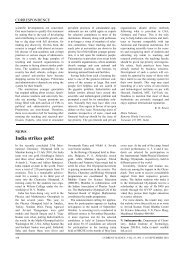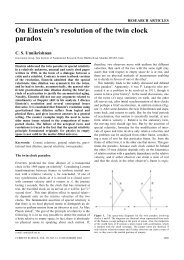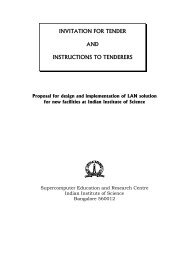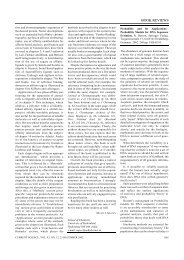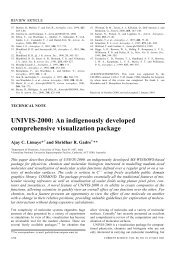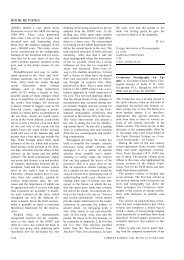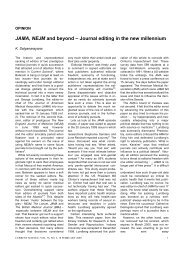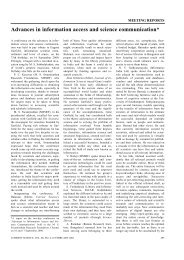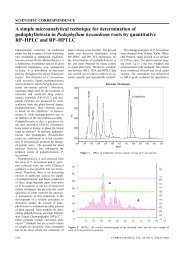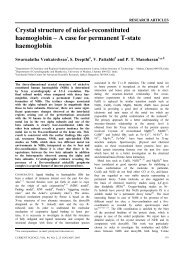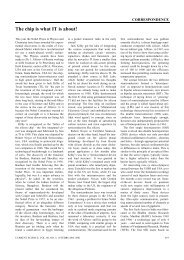(Mangifera indica L) cultivars
(Mangifera indica L) cultivars
(Mangifera indica L) cultivars
You also want an ePaper? Increase the reach of your titles
YUMPU automatically turns print PDFs into web optimized ePapers that Google loves.
SCIENTIFIC CORRESPONDENCE<br />
15. Schopf, J. W., Ford, T. D. and Breed, W. J.,<br />
Science, 1973, 179, 1319–1321.<br />
16. Schopf, J. W., J. Palaeontol., 1968, 45, 651–<br />
668.<br />
17. Campbell, S. E., Nature, 1982, 299, 429–<br />
431.<br />
18. Lukas, K. J., Geol. Soc. America, Abstract<br />
with programs, 1978, 10, 448.<br />
19. Golubic, S., Perkins, R. D. and Lukas, K. J.,<br />
In the Study of Trace Fossils, Springer-Verlag,<br />
1975, pp. 229–259.<br />
20. Auden, J. B., Rec. Geol. Surv. India, 1934,<br />
67, 357–454.<br />
Received 5 January 2004; revised accepted 16<br />
June 2004<br />
1 Birbal Sahni Institute of<br />
Palaeobotany,<br />
53, University Road,<br />
MANOJ SHUKLA 1, *<br />
RUPENDRA BABU 1<br />
V. K. MATHUR 2<br />
D. K. SRIVASTAVA 2<br />
Lucknow 226 007, India<br />
2 Geological Survey of India,<br />
Northern Region,<br />
Aliganj,<br />
Lucknow 226 024, India<br />
*For correspondence<br />
e-mail: manoj_shukla_1999@yahoo.com<br />
Diverse genetic bases of Indian polyembryonic and monoembryonic<br />
mango (<strong>Mangifera</strong> <strong>indica</strong> L) <strong>cultivars</strong><br />
870<br />
Mango is one of the most important fruit<br />
crops in India. It is known to have been<br />
cultivated in India since the last 4000<br />
years. Almost all <strong>cultivars</strong> belong to the<br />
species Mangifiera <strong>indica</strong>, family Anacardiaceae.<br />
M. <strong>indica</strong> is native to India<br />
and occurs abundantly in forests and cultivated<br />
areas. Hence, it is difficult to differentiate<br />
true wild forms from cultivated<br />
ones. The commercially grown <strong>cultivars</strong><br />
have arisen through seedling selections<br />
made for different fruit characters like<br />
colour, taste, flavour, size, etc. Later, these<br />
<strong>cultivars</strong> have been vegetatively propagated<br />
and cultivated in a wide area 1 .<br />
Mango <strong>cultivars</strong> are classified into two<br />
groups: monembryonic type or Indian type<br />
and polyembryonic type or Indo-Chinese<br />
type 2 . In India, majority of the cultivated<br />
types are monoembryonic. Surprisingly,<br />
polyembryonic types were grown only in<br />
southern India, especially in coastal parts<br />
of Kerala, Karnataka and Goa.<br />
Emergence of multiple seedlings from<br />
a single seed is referred to as polyembryony.<br />
This was observed in 59 families,<br />
158 genera and 239 species 3 . In<br />
mango, Sachar and Chopra 4 observed<br />
nucellar embryos in nineteen mango<br />
varieties. Using crosses of polyembryonic<br />
and monoembryonic <strong>cultivars</strong> and<br />
their segregating hybrids, Arnon et al. 5<br />
demonstrated that polyembryony in<br />
mango is controlled by a single dominant<br />
gene. Polyembryonic and monoembryonic<br />
types are intercrossable, and cultivation<br />
of polyembryonic varieties is confined to<br />
the west coast adjacent to the Western<br />
Ghats, which is one of the hot spots of<br />
biodiversity. Keeping this in view, the<br />
present study was carried out to examine<br />
whether these two classes have a common<br />
or different genetic base using Random<br />
Amplified Polymorphic DNA<br />
(RAPD) and chloroplast DNA Restriction<br />
Fragment Length Polymorphism<br />
(RFLP) analysis.<br />
In this study, ten polyembryonic and<br />
monoembryonic <strong>cultivars</strong> each traditionally<br />
grown in the west coast of southern<br />
India were used to determine the genetic<br />
relatedness among them using RAPD<br />
markers (Table 1). DNA isolation and<br />
RAPD analysis were carried out as described<br />
by Ravishankar et al. 6 . We have<br />
employed 19 random primers which amplified<br />
153 polymorphic and 33 monomorphic<br />
markers.<br />
Eight mango <strong>cultivars</strong> from each of<br />
these groups were used for chloroplast<br />
DNA RFLP analysis. The primers ORF<br />
106-rbcL and GIF-GI460 were used to<br />
amplify chloroplast-specific DNA fragments<br />
7,8 . They amplified around 3.1 kb<br />
and 1.5 kb fragments respectively. ORF<br />
106-rbcL products were restriction-digested<br />
with six enzymes, EcoRI, BamHI,<br />
XbaI, XhoI, TaqI and PstI. Digested PCR<br />
Serial<br />
no.<br />
P1<br />
P2<br />
P3<br />
P4<br />
P5<br />
P6<br />
P7<br />
P8<br />
P9<br />
P10<br />
Table 1.<br />
fragments were separated on 2% agarose.<br />
Except PstI, no other enzyme digested<br />
PCR-amplified fragments. PstI digestion<br />
produced similar bands. Therefore, data<br />
from restriction digestion of ORF-rbcL<br />
fragment were not used for statistical analysis.<br />
For GIF-G1460 products, 15 enzymes<br />
were used for restriction digestion.<br />
BamHI, HaeIII, HindIII, HinfI, MspI,<br />
PstI, TaqI and XbaI were able to digest<br />
amplified DNA. Restriction enzymes BglII,<br />
DraI, EcoRI, EcoRV, KpnI, PvuII, and<br />
XhoI did not digest GIF-G1460 amplified<br />
fragments. Bands on agarose gel were<br />
scored as in the case of RAPD. Data<br />
from RAPD markers and chloroplast DNA<br />
RFLP markers were used for cluster analysis<br />
and principal component analysis<br />
(PCA), separately 9 . For cluster analysis,<br />
squared Euclidian distances were calculated<br />
for pair-wise differences among <strong>cultivars</strong><br />
and based on minimum variance algorithm,<br />
the dendrogram was constructed 10 .<br />
Dendrogram analysis of RAPD and<br />
chloroplast DNA RFLP data clearly grouped<br />
the <strong>cultivars</strong> into two based on<br />
Polyembryonic and monoembryonic <strong>cultivars</strong> used<br />
in this study<br />
Polyembryonic cultivar<br />
Peach<br />
Kurukkan<br />
Mylupilian<br />
Vellaikulumban<br />
Muvandam<br />
Bappakai<br />
Nekkare<br />
Olour<br />
Chandrakaran<br />
Starch<br />
Serial<br />
no.<br />
M1<br />
M2<br />
M3<br />
M4<br />
M5<br />
M6<br />
M7<br />
M8<br />
M9<br />
M10<br />
Monoembryonic <strong>cultivars</strong><br />
Rumani<br />
Raspuri<br />
Totapuri<br />
GoaMankurd<br />
Alphonso<br />
Xavier<br />
Kadari<br />
Padari<br />
Suvarnarekha<br />
Banganapalli<br />
CURRENT SCIENCE, VOL. 87, NO. 7, 10 OCTOBER 2004
SCIENTIFIC CORRESPONDENCE<br />
Figure 1. Cluster analysis of RAPD makers generated for polyembryonic and monoembryonic<br />
mango <strong>cultivars</strong>. Suffix (P) denotes polyembryonic <strong>cultivars</strong>, others are monoembryonic <strong>cultivars</strong>.<br />
1. Mukherjee, S. K., Econ. Bot., 1972, 26,<br />
260–264.<br />
2. Rhodes, A. M., Campbell, C., Malo, S. E.<br />
and Carmer, S. G., J. Am. Soc. Hortic. Sci.,<br />
1970, 95, 252–256.<br />
3. Tisserat, B., Esen, E. B. and Murashige,<br />
T., Hortic. Rev., 1979, 1, 1–72.<br />
4. Sachar, R. C. and Chopra, R. N. Indian J.<br />
Agric. Sci., 1957, 27, 219–228.<br />
5. Arnon, Y., Czosnek, H. and Gazit, S.<br />
Hortic. Sci., 1998, 33,1241–1242.<br />
6. Ravishankar, K. V., Lalitha Anand and<br />
Dinesh, M. R., J. Hortic. Sci. Biotechnol.,<br />
2000, 75, 198–201.<br />
7. Eiadthong, W., Yonemori, K., Sugiura,<br />
A., Utsunomiya, N. and Subhadrabandhu,<br />
S., Sci. Hortic., 1999, 80, 145–155.<br />
8. Dayanandan, S., University of Concordia.<br />
Canada primers are designed from rbcL<br />
sequences of Gossypium hirsutum (GB-<br />
M77700). G1F-atg tca cca caa aca gag<br />
act aaa gc and G1460R cct ttt agt aaa aga<br />
ttg ggc cga g. Amplification conditions<br />
were 35 cycles at 94°C for 1 min, 40°C<br />
for 1 min, 72°C for 2 min with initial denaturation<br />
for 3 min and final extension<br />
for 8 min (pers. commun).<br />
9. Sokal, R. R. and Sneath, P. H. A., Principles<br />
of Numerical Taxonomy, W. H.<br />
Freeman and Co, San Francisco, USA, 1973.<br />
10. Ward, J. H., J. Am. Stat. Assoc., 1963,<br />
58, 236–239.<br />
11. Lopez-Valenzuela, J. A., Martinez, O.<br />
and Pardes-Lopez, O., Hortic. Sci. 1997,<br />
32, 1105–1108.<br />
ACKNOWLEDGEMENTS. K.V.R. and M.R.D.<br />
were partly supported through ADB–IPGRI<br />
project on Mango Collection and Utilization.<br />
Figure 2. Cluster analysis of chloroplast DNA RFLP markers generated for Indian monoembryonic<br />
and polyembryonic mango <strong>cultivars</strong>. Suffix (P) denotes polyembryonic <strong>cultivars</strong>.<br />
Received 21 November 2002; revised accepted<br />
16 June 2004<br />
embryo types, i.e. monoembryonic and<br />
polyembryonic (Figures 1 and 2). PCA also<br />
confirms these results, where monoembryonic<br />
and polyembryonic <strong>cultivars</strong> were<br />
clustered separately (data not shown; Eigenvalue<br />
58.5%). In another study, Lopez-<br />
Valenzuela et al. 11 were able to differentiate<br />
mango <strong>cultivars</strong> by embryo type and<br />
geographical origin using RAPD markers.<br />
However, in their study, monoembryonic<br />
and polyembryonic types used were from<br />
different geographical regions (Mexico,<br />
Philippines and Florida). In the present<br />
study, we have used seedling selections<br />
from the same geographical region,<br />
where they have been traditionally grown<br />
over the years.<br />
Both the embryonic types are intercrossable<br />
and polyembryony is governed<br />
by a single dominant gene. Therefore, we<br />
have employed RAPD analysis using total<br />
genomic DNA and chloroplast DNA RFLP<br />
analysis to study the genetic relatedness<br />
and lineage among polyembryonic and<br />
monoembryonic <strong>cultivars</strong>. In both the analyses,<br />
the grouping of <strong>cultivars</strong> based on<br />
their embryo types <strong>indica</strong>tes that monoembryonic<br />
and polyembryonic types of<br />
Indian mango <strong>cultivars</strong> have a different<br />
genetic base. These results suggest that<br />
the polyembryonic types might have been<br />
introduced from other parts of southeast<br />
Asia and are unlikely to have originated<br />
from India.<br />
K. V. RAVISHANKAR 1, *<br />
P. CHANDRASHEKARA 1,3<br />
S. A. SREEDHARA 1<br />
M. R. DINESH 2<br />
LALITHA ANAND 1<br />
G. V. S. SAIPRASAD 1<br />
1 Division of Biotechnology,<br />
2 Division of Fruit Crops,<br />
Indian Institute of Horticultural Research,<br />
Hessaraghatta Lake Post,<br />
Bangalore 560 089, India<br />
3 Present address:<br />
Centre for Cellular and Molecular Biology,<br />
Hyderabad 500 007, India<br />
*For correspondence<br />
e-mail: kv_ravishankar@yahoo.co.in<br />
CURRENT SCIENCE, VOL. 87, NO. 7, 10 OCTOBER 2004 871



